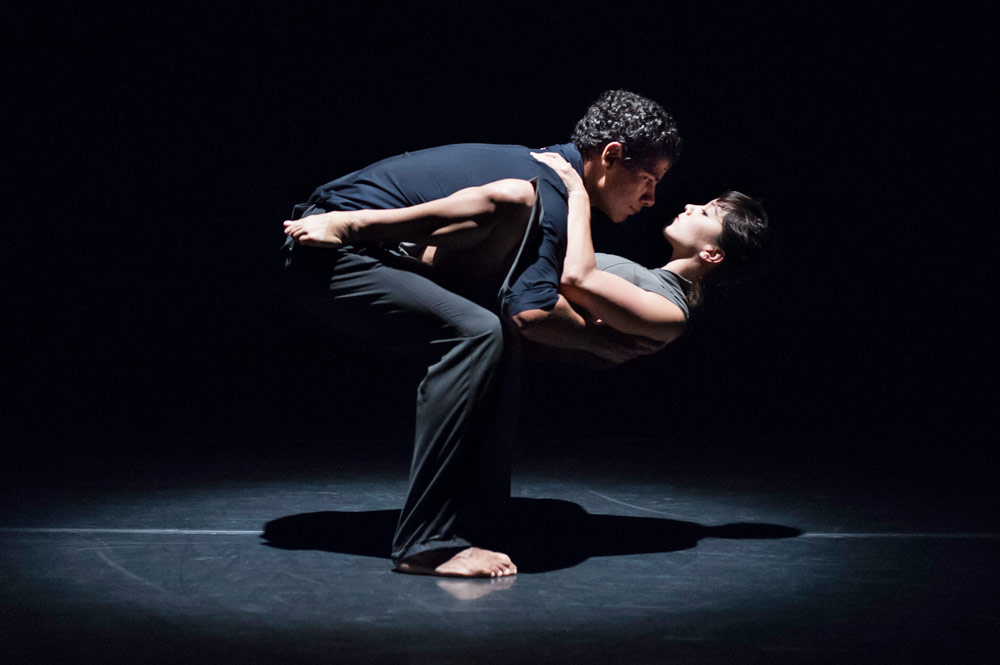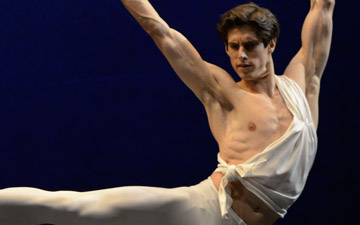
© Keira Heu-Jwyn Chang. (Click image for larger version)
Kate Weare Company
Tenth Anniversary Season: excerpt from Bridge of Sighs, excerpt from Drop Down, Volver, excerpt from Bright Land, Unstruck
New York, Brooklyn Academy of Music
19 February 2015
www.kateweare.com
www.bam.org
Love is War
Ten years is an eternity in the life of a small dance company, particularly in this brutal financial climate for the arts. But choreographers are persistent folk, and Kate Weare, a Californian who has adopted New York as her artistic home, has held on through thick and thin. (The persistence has paid off; she received a Guggenheim Fellowship last year.) Her retrospective, currently at BAM’s Fishman Space, reveals a single-minded artist of considerable dramatic force. Her dances – mainly duets – impose themselves, holding your interest even as they may make you slightly uncomfortable. They’re a bit like watching a couple fight at the next table: you’re never sure what might happen next, or who might get hurt.
There’s something almost too private about the way these dancers handle each other. Weare’s natural habitat is the duet, which in many cases has the flavor of a mortal combat. As in martial arts, a clear source of inspiration, the movements are jabbing, forceful and involve the whole body, assisted by sharp intakes or exhalations of breath. You hear the whoosh of limbs slicing through air, the slapping of skin, the thud of soft tissue. In one of the duets, a woman swipes her arm, with great force, in the direction of her partner, who – like a ninja – bends his back just in time to escape the blow. Not all the men are so lucky: at the end of one of the duets, an unfortunate man was pounded into the ground by a series of head-butts to the chest. These are not women to be trifled with.

© Keira Heu-Jwyn Chang. (Click image for larger version)
It’s all extremely visceral: flesh against flesh, will against will, vulnerability masking as power, the struggle for mental and physical independence. The women demand attention and use their bodies with force and an almost complete absence of conventional feminine grace. But partnering demands a certain degree of acquiescence; herein lies the tension. In a program note, Weare writes that the first duet on the program, an excerpt from her 2008 Bridge of Sighs, was made when she was “on the cusp of marriage…[as an expression of] my youthful, white-hot fear of losing autonomy.” White hot it is, and bruising. The man and woman (Douglas Gillespie and Leslie Kraus) square off, and the grappling begins. For a moment there is a reprieve: he kisses her on the neck. But is this, in itself, a kind of power move on his part? The question is never fully resolved. The content of Drop Down, an excerpt from 2007, is more overtly sexual: the tussling very clearly denotes the abandon and hunger of lovemaking. Weare can be extremely frank. The man slowly rubs his pelvis against his partner as she lies prone beneath him; she acquiesces to this intimate ecstasy, however briefly. She too has her desires; she crouches on his thighs, her own thighs white and exposed. Weare heightens, but doesn’t theatricalize the movement. It is what it is.

© Keira Heu-Jwyn Chang. (Click image for larger version)
It helps that her dancers are interesting to look at, in the way that real people are. You wouldn’t be surprised to see these people at the supermarket, or the park. Leslie Kraus is blonde and petite, with strong kick-boxer’s legs. Douglas Gillespie is calm and coiled to strike; his face wears a wry half-smile, like a sadist plotting his next move. Two guests from the ODC/Dance company, Joseph Hernandez and Natasha Adorlee, seemed younger, more inward and more self-consciously dancerly (Hernandez had a gently lyrical quality). T.J. Spaur is tall, thoughtful, detached, sensual. His male duet with Gillespie (“Volver,” a première set to Violetta Parra’s heartbreaking “Volver a los Diecisiete”) revolves around the smooth walking and embrace of the tango. Out of this calm, formal structure emerges tangled partnering riddled with dragging lifts and ingenious ricochets off the hip and the leg. But where male-female relationships seem to bring out Weare’s most ferocious side, this male duet is more measured, more impartial. She is an observer here, not a direct participant.

© Keira Heu-Jwyn Chang. (Click image for larger version)
Because of Weare’s fixation with certain themes – love, desire, power, need – her palette is limited. Her ideas don’t lend themselves to larger ensembles. (In a way, all Weare’s dances are like tangos.) For this reason the final work on the program, a trio, was the least convincing. On the one hand it made good use of the sculptural possibilities offered by the intertwining of three bodies. Nicole Diaz, the sole woman, arched and rounded her magnificent back, exposed in a silk backless blouse, turning her body into a strange landscape, each notch of her spinal cord protruding like a boulder on a lunar surface. The work, Unstruck, seemed to suggest a theme of solitude; individuals held poses (some almost balletic) beneath a golden light, before being manipulated into new shapes by the others. (Weare doesn’t use sets; the clothing is more or less derived from street-wear.) But the tension flagged as allegiances formed and dissolved between the three. The development of ideas over a long period isn’t Weare’s strongest suit, and her general preference for soundscapes over musical accompaniment adds to this sense of meandering. The steps respond to their own impulse, and expose their own rhythms, but phrases seldom develop; the momentum is start and stop. Still, it’s not often that one encounters a choreographer whose style is so deeply personal, honest, and so wholly her own.

















You must be logged in to post a comment.